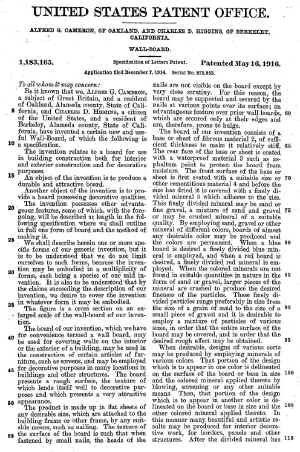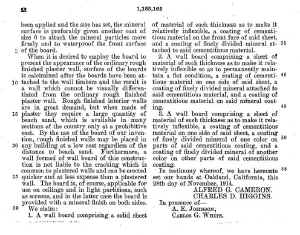
FTL Design
History of Technology
Zenitherm Architectural Wall & Floor Material
Patent Specification
 |
FTL Design |
Zenitherm Architectural Wall & Floor Material |
|
|
UNITED STATES PATENT OFFICE. ALFRED G. CAMERON, OF OAKLAND, AND CHARLES D. HIGGINS OF BERKELEY, CALIFORNIA. WALLBOARD.
Be it known that we, ALFRED G. CAMERON, a subject of Great Britain, and a resident of Oakland, Alameda county, State of California, and CHARLES D. HIGGINS, a citizen of the United States, and a resident of Berkeley, Alameda county, State of California, have invented a certain new and useful Wall-Board, of which the following is a specification. The invention relates to a board for use in building construction both for interior and exterior construction and for decorative purposes. An object of the invention is to produce a durable and attractive board. Another object of the invention is to provide a board possessing decorative qualities. The invention possesses other advantageous features, some of which, with the foregoing, will be described at length in the following specification where we shall outline in full one form of board and the method of making it. We shall describe
herein one or more specific forms of our generic invention, but it is
to be understood that we do not limit ourselves to such forms, because
the invention may be embodied in a multiplicity of forms, each being a
species of our said invention. It is also to be understood that by the
claims succeeding the description of our invention, we desire to cover
the invention in whatever form it may be embodied. The figure is a cross section on an enlarged scale of the wall-board of our invention. The board of our invention, which we have for convenience termed a wall board, may be used for covering walls on the interior or the exterior of a building, may be used in the construction of certain articles of furniture, such as screens, and may be employed for decorative purposes in many locations in buildings and other structures. The board presents a rough surface, the texture of which lends itself well to decorative purposes and which presents a very attractive appearance. The product is made up in flat sheets of any desirable size, which are attached to the building frame other frame, by any suitable means, such as nailing. The texture of the surface of the board is such that when fastened by small nails, the heads of the nails are not visible on the board except by very close scrutiny. For this reason, the board may be supported and secured by the nails at various points over its surface; an advantageous feature over prior wall boards, which are secured only at their edges and are, therefore, prone to bulge. The board of our invention consists of a base or sheet of fibrous material 2, of sufficient thickness to make it relatively stiff. The rear face of the base or sheet is coated with a waterproof material 3 such as asphaltum paint to protect the board from moisture. The front surface of the base or sheet is first coated with a suitable size or other cementitious material 4 and before the size has dried it is covered with a finely divided mineral 5 which adheres to the size. This finely divided mineral may be sand or fine gravel, a mixture of sand and gravel or may be crushed mineral of a suitable quality. By employing sand, gravel or other mineral of different colors, boards of almost any desirable color may be produced and the colors are permanent. When a blue board is desired a finely divided blue mineral is employed, and when a red board is desired, a finely divided red mineral is employed. When the colored minerals are not found in suitable quantities in nature in the form of sand or gravel, larger pieces of the mineral are crushed to produce the desired fineness of the particles. These finely divided particles range preferably in size from the size of a grain of sand to the size of a small piece of gravel and it is desirable to employ a mixture of particles of various sizes, in order that the entire surface of the board may be covered, and in order that the desired rough effect may be obtained. When desirable, designs of various sorts may be produced by employing minerals of various colors. That portion of the design which is to appear in one color is delineated on the surface of the board or base in size and the colored mineral applied thereto by blowing, screening or any other suitable means. Then, that portion of the design which is to appear in another color is delineated on the board or base in size and the other colored mineral applied thereto. In this manner many beautiful and artistic results may be produced for interior decorative work, for borders, panels and other structures. After the divided mineral has been applied and the size has set, the mineral surface is preferably given another coat of size 6 to attach the mineral particles more firmly and to waterproof the front surface of the board. When it is desired to employ the board to present the appearance of the ordinary rough finished plaster wall, surface of the boards is calcimined after the boards have been attached to the wall timbers and the result is a wall which cannot be visually differentiated from the ordinary rough finished plaster wall. Rough finished interior walls are in great demand, but when made of plaster they require large quantity of beach sand, which is available in many sections of the country only at a prohibitive cost. By the use of the board of our invention, rough finished walls may be placed in any building at a low cost regardless of the distance to beach sand. Furthermore, a wall formed of wall board of this construction is not liable to the cracking which is common to plastered walls and can be erected quicker and at less expense than a plastered wall. The board is, of course, applicable for use on ceilings and in light partitions, such as screens, and in the latter case the board is provided with a mineral finish on both sides. We claim: 1. A wall board comprising a solid sheet of material of such thickness as to make it relatively inflexible, a coating of cementitious material. on the front face of said sheet, and a coating of finely divided mineral attached to said cementitious material. 2. A wall board comprising a sheet of material of such thickness as to make it relatively inflexible so as to permanently maintain a flat condition, a coating of cementitious material on one side of said sheet, a coating of finely divided mineral attached to said cementitious material, and a coating of cementitious material on said mineral coating. 3. A wall board comprising a sheet of material of such thickness as to make it relatively inflexible, a coating of cementitious material on one side of said sheet, coating of finely divided mineral of one color on parts of said cementitious coating, and a coating of finely divided mineral of another color on other parts of said cementitious coating. In testimony whereof, we have hereunto set our hands at Oakland, California, this 28th day of November, 1914. ALFRED G. CAMERON. In presence of- |
|||||||
|
Click here for a printable image of the front page, showing the figure |
|||||||
 |
 |
||||||
Copyright © 2006 FTL Design
Last revised: 22 October 2006